Glen Deas supplied negatives of 80-153 and the Z80 cards, thanks!
I also added the information I have on Apple ][ cards by John Bell, like the 6522 VIA and A/D cards.
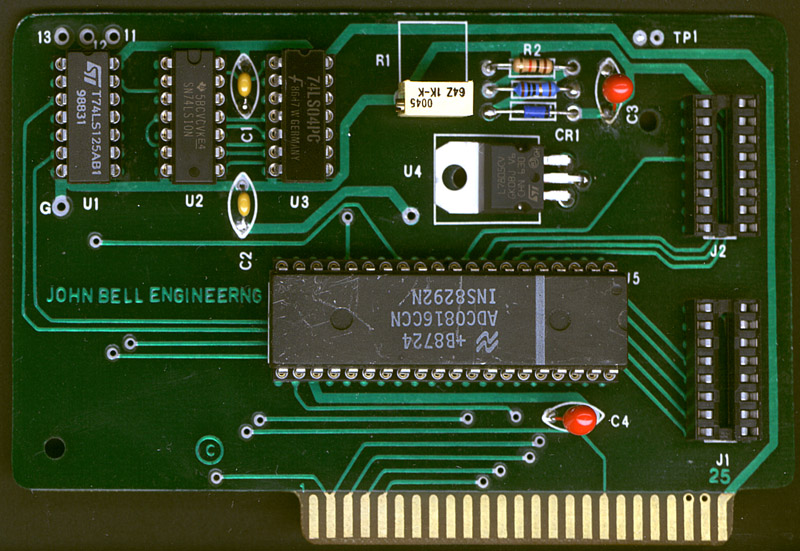
About small SBC systems
Glen Deas supplied negatives of 80-153 and the Z80 cards, thanks!
I also added the information I have on Apple ][ cards by John Bell, like the 6522 VIA and A/D cards.

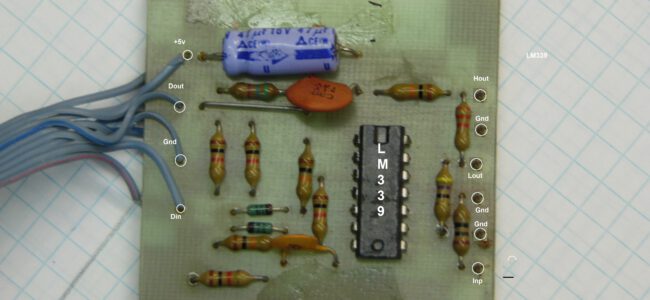
Glen Deas sent me an article about the Ziptape cassette interface, 1978, by the late Lew Edwards. Glen made a PCB for it.
The article about the Fast Cassette Interface is part of my CW Moser Assembler/editor package. Scanned by me in 2010 to the file kimfastcassette.pdf and on my website with the CW Moser package for years now .
Glen Deas knew it was designed by Lew Edwards and entered the source in modern assembler format.
Page 1 A65 65C02 Assembler 1.16
Line# Loc Code Line
1
2 ;-----------------------------------------------------------------------------------------------------------
3 ; E:\ZIPTAPE>CSC ZIPTAPE1.ASM
4 ;
5 ; E:\ZIPTAPE>CSC6502 ZIPTAPE1.ASM
6 ; Page 1 File ZIPTAPE1.ASM
7 ;
8 ;
9 ; ORG $4000
10 4000 * = $4000
11 ; ***Irk FAST CASSETTE INTERFACE
12 ; (CONFIGURED FOR KIM)
13 ;================================================================
14 ;modified for CSC 6502 Cross Assembler Glen Deas K5GED 1/11/2023
15 ;================================================================
16 ;To use this software, enter data in memory locations 0123
17 ;as follows: 0123 = LOAD/NO
18 ; 0124-0125 = START ADDRESS
19 ; 0126-0127 = END ADDRESS
20 ;The record routine will record from START ADDRESS to END ADDRESS
21 ;LOAD/NO has no meaning to the record software.;
22 ;
23 ;The load routine will load from START ADDRESS to END ADDRESS
24 ;store data in memory onl if LOAD/NO does not =al 0. Where
25 ;LOAD/NO can be used for verifying and unconditionally selecting
26 ;modules on tape.
27 ;
28 ;The load and record routines have callable entry points at
29 ;(4000) and CREAD (40A5), and non-ccallable entry points at
30 ;LDENTRY (4141) and RCENTRY (4152). If CREAD is called, the
31 ;Z bit in the PSR will be treu on return if no error was detected
32 ;and false if errors occurred. If execution is at the non callable
33 ;entry LDENTRY, a break (via BRK instruction) will be execcuted
34 ;at end of loading and register A will indicate if the data was
35 ;loaded correctly: R(A)=00 for good load, and EE for errors.
36 ;
37 ;
38 1702 CPORT = $1702 ;CASSETTE I/O
39 1703 CPORTD = $1703 ;PORT DIRECTION REGISTER
40 ;BIT 3 = WRITE TO CASSETTE; BIT 2 - READ FROM CASSETTE
41 ;
42 ;
43 ; :== VARIABLES ==
44 00B2 CHECKSUM = $00B2
45 00B6 ADDRS = $00B6
46 00B6 COUNT = ADDRS
47 00B4 FORMBYTE = $00B4
48 00B4 SYNCCOUNT = FORMBYTE
49 00B5 BITCOUNT = $00B5
50 ;
51 ;INPUT PARMS
52 0123 LOADNO = $0123
53 0124 TSTART = $0124
54 0126 TEND = $0126
55 ;
56 ;CWRITE: WRITE TO TAPE FROM (START) TO (END)
57 ;
58 4000 AD 03 17 CWRITE LDA CPORTD
59 4003 09 08 ORA #%00001000 ;BIT 3 FOR OUTPUT ON PIA
60 4005 8D 03 17 STA CPORTD
Page 2 A65 65C02 Assembler 1.16
Line# Loc Code Line
61 ;THE ABOVE INITIALIZES BIT 3 FOR OUTPUT ON PIA
62 4008 A9 20 LDA #$20 ;32 TIMES
63 400A 85 B6 STA COUNT
64 400C A9 16 LPRECST LDA #$16 ;SYNC CHAR.
65 400E 20 41 40 JSR WRITEBYTE
66 4011 A9 10 LDA #$10
67 4013 85 B4 STA SYNCCOUNT
68 4015 20 5D 40 LPDELA JSR OUTZERO
69 4018 C6 B4 DEC SYNCCOUNT
70 401A D0 F9 BNE LPDELA
71 ;DELAY TIME FOR SYNC
72 401C C6 B6 DEC COUNT
73 401E D0 EC BNE LPRECST
74 4020 20 84 40 JSR MOVESTAD
75 4023 A9 0F LDA #$0F ;RECORD START CHAR.
76 4025 20 41 40 JSR WRITEBYTE
77 4028 A2 00 LDX #$00
78 402A 86 B2 STX CHECKSUM ;CLEAR CHECKSUM LOW BYTE
79 402C 86 B3 STX CHECKSUM+1 ;AND HIGH BYTE
80 ;
81 402E A1 B6 LOOPDATA LDA (ADDRS,X) ;LOAD DATA INDEXED BY X REG
82 4030 20 41 40 JSR WRITEBYTE
83 4033 20 8F 40 JSR INCCOMP
84 4036 90 F6 BCC LOOPDATA
85 4038 A5 B3 LDA CHECKSUM+1
86 403A 48 PHA SAVE HI CKSUM
87 403B A5 B2 LDA CHECKSUM
88 403D 20 41 40 JSR WRITEBYTE WRITE LO CKSUM FIRST
89 4040 68 PLA HI CKSUM NEXT
90 ;THE ABOVE WRITES BOTH CHECKSUM BYTES
91 ;
92 ;ROUTINE TO WRITE A BYTE TO TAPE
93 ;
94 4041 85 B4 WRITEBYTE STA FORMBYTE
95 4043 20 34 41 JSR CKSUMADD UPDATE CHECKSUM COUNTER
96 4046 20 7C 40 JSR OUTONE START BIT
97 4049 A9 08 LDA #$08 8 BITS
98 404B 85 B5 STA BITCOUNT
99 404D 06 B4 DATALOOP ASL FORMBYTE SHIFT LEFT INTO CARRY
100 404F 90 05 BCC ZEROBIT
101 4051 20 7C 40 ONEBIT JSR OUTONE
102 4054 F0 03 BEQ CKENDBY
103 4056 20 5D 40 ZEROBIT JSR OUTZERO
104 4059 C6 B5 CKENDBY DEC BITCOUNT
105 405B D0 F0 BNE DATALOOP
106 ;NOT OUTPUT 1 STOP BIT
107 ;
108 ;ROUTINE OUTPUT A ZERO TO TAPE
109 ;
110 405D A9 20 OUTZERO LDA #$20 '0' DELAY CONSTANT
111
112 ;:ROUTINE WRITE TO TAPE
113 ;
114 405F 48 WRITE PHA SAVE DELAY CONSTANT
115 4060 AD 02 17 LDA CPORT
116 4063 09 08 ORA #%00001000 ;OUT A" ON BIT 3
117 4065 8D 02 17 STA CPORT
118 4068 68 PLA
119 4069 48 PHA
120 406A AA TAX DELAY CONSTANT
Page 3 A65 65C02 Assembler 1.16
Line# Loc Code Line
121 406B 20 78 40 JSR LOOPD
122 406E AD 02 17 LDA CPORT
123 4071 29 F7 AND #%11110111 ;OUT A '01 ON BIT 3
124 4073 8D 02 17 STA CPORT
125 4076 68 PLA
126 4077 AA TAX DELAY CONSTANT
127 4078 CA LOOPD DEX
128 4079 D0 FD BNE LOOPD
129 407B 60 RTS
130 ;
131 ;ROUTINE OUTPUT A ONE TO TAPE
132 ;
133 407C A9 50 OUTONE LDA #$50 '1' DELAY CONSTANT
134 407E D0 DF BNE WRITE
135 ;DELAY FOR '0' TIME FOR READ
136
137 4080 A2 30 READDELAY LDX #$30
138 4082 D0 F4 BNE LOOPD
139 ;
140 ;ROUTINE MOVE FROM START TO ADDRS
141 ;
142 4084 AD 24 01 MOVESTAD LDA TSTART
143 4087 85 B6 STA ADDRS
144 4089 AD 25 01 LDA TSTART+1
145 408C 85 B7 STA ADDRS+1
146 408E 60 RTS
147 ;:ROUTINE INCREMENT AND COMPARE
148
149 408F E6 B6 INCCOMP INC ADDRS
150 4091 D0 02 BNE SKIPINC
151 4093 E6 B7 INC ADDRS+1
152 4095 A5 B7 SKIPINC LDA ADDRS+1
153 4097 CD 27 01 CMP TEND+1
154 409A 90 08 BCC NOTEND
155 409C A5 B6 LDA ADDRS
156 409E CD 26 01 CMP TEND
157 40A1 90 01 BCC NOTEND
158 40A3 38 SEC
159 40A4 60 NOTEND RTS
160 ;ON RETURN, C=CLEAR: NOTEND: C=SET: END REACHED
161 ;
162 40A5 A2 00 CREAD LDX #$00
163 40A7 86 B6 STX COUNT
164 40A9 20 EF 40 LOOPLOAD JSR READBYTE
165 40AC C9 16 CMP #$16 SYNC
166 40AE D0 04 BNE SKIP1
167 40B0 E6 B6 INC COUNT
168 40B2 D0 F5 BNE LOOPLOAD
169 40B4 A4 B6 SKIP1 LDY COUNT
170 40B6 C0 0A CPY #$0A ;MUST B >= 10 SYNC'S
171 40B8 90 EB BCC CREAD
172 40BA C9 0F CMP #$0F RECORD START
173 40BC D0 E7 BNE CREAD
174 40BE A0 00 LDY #$00
175 40C0 84 B2 STY CHECKSUM
176 40C2 84 B3 STY CHECKSUM+1 LAR CHECKSUM LOCATIONS
177 40C4 20 84 40 JSR MOVESTAD START > ADDRS (2)
178 ;
179 ;NOW LOAD DATA
180
Page 4 A65 65C02 Assembler 1.16
Line# Loc Code Line
181 40C7 20 EF 40 LOOP69 JSR READBYTE
182 40CA AC 23 01 LDY LOADNO ;CKG IF TO STORE
183 40CD F0 02 BEQ SKIPSTOR
184 40CF 81 B6 STA (ADDRS,X)
185 40D1 20 8F 40 SKIPSTOR JSR INCCOMP
186 40D4 90 F1 BCC LOOP69
187 40D6 A5 B3 LDA CHECKSUM+1
188 40D8 48 PHA SAVE CHKSUM HI
189 40D9 A5 B2 LDA CHECKSUM
190 40DB 48 PHA SAVE CHKSUM LO
191 40DC 20 EF 40 JSR READBYTE
192 40DF 68 PLA
193 40E0 C5 B4 CMP FORMBYTE CHECK CHECKSUM LO
194 40E2 D0 07 BNE RETURN
195 40E4 20 EF 40 JSR READBYTE
196 40E7 68 PLA
197 40E8 C5 B4 CMP FORMBYTE CHECK CHECKSUM HI
198 40EA 60 RTS
199 40EB 68 RETURN PLA
200 40EC A9 FF LDA #$FF CLEAR Z-BIT
201 40EE 60 RTS
202 ;ON RETURN Z-BIT = TRUE:GOOD LOAD: Z-BIT ==FALSE: ERROR
203 ;
204 ;ROUTINE READ A BYTE FROM TAPE
205 ;
206 40EF 20 2E 41 READBYTE JSR INPORT
207 40F2 D0 FB BNE READBYTE LOOP UNTIL 0
208 40F4 20 2E 41 WAITFORI JSR INPORT
209 40F7 F0 FB BEQ WAITFORI LOOP UNTIL 1
210 40F9 20 80 40 JSR READDELAY
211 40FC 20 2E 41 JSR INPORT
212 40FF F0 F3 BEQ WAITFORI IF ZERO
213 4101 20 2E 41 WAITFORO JSR INPORT
214 4104 D0 FB BNE WAITFORO WAIT TIL END OF START BIT
215 4106 A9 08 LDA #$08
216 4108 85 B5 STA BITCOUNT
217 410A 20 2E 41 WAITTOCN JSR INPORT
218 410D F0 FB BEQ WAITTOCN ;LOOP UNTIL '1'
219 410F 20 80 40 JSR READDELAY
220 4112 20 2E 41 JSR INPORT
221 4115 F0 08 BEQ PROCESSO IF '0' THENZERO, ELSE ONE
222 ;
223 4117 20 2E 41 PROCESS1 JSR INPORT
224 411A D0 FB BNE PROCESS1 ;LOOP UNTIL '0
225 411C 38 SEC
226 411D B0 01 BCS ROTATEIN
227 411F 18 PROCESSO CLC
228 ;
229 4120 26 B4 ROTATEIN ROL FORMBYTE ;ROTATE CARRY
230 4122 C6 B5 DEC BITCOUNT
231 4124 D0 E4 BNE WAITTOCN
232 4126 A5 B4 LDA FORMBYTE
233 4128 20 34 41 JSR CKSUMADD UPDATE CHECKSUM
234 412B A5 B4 LDA FORMBYTE
235 412D 60 RTS
236 ;
237 ;
238 ;INPUT FROM TAPE
239 ;
240 412E AD 02 17 INPORT LDA CPORT
Page 5 A65 65C02 Assembler 1.16
Line# Loc Code Line
241 4131 29 04 AND #%00000100 ;MASK OUT ALL BUT BIT 2
242 4133 60 RTS
243 ;
244 ;
245 ;UPDATE CHEKSUM COUNTERS
246 ;
247 4134 18 CKSUMADD CLC
248 4135 D8 CLD
249 4136 65 B2 ADC CHECKSUM+$00 AD R(A) TO CKSUM LO
250 4138 85 B2 STA CHECKSUM+$00
251 413A A9 00 LDA #$00
252 413C 65 B3 ADC CHECKSUM+1 ADD 00 TO CKSUM HI
253 413E 85 B3 STA CHECKSUM+1
254 4140 60 RTS
255 ;
256 ;
257 4141 20 A5 40 LOADENTRY JSR CREAD
258 4144 D0 08 BNE BAD
259 4146 A9 00 LDA #$00 INDICATE GOOD LOAD BY R(A) =
260 4148 00 B BRK
261 4149 EA NOP
262 414A EA NOP
263 414B 4C 41 41 JMP LOADENTRY
264 414E A9 EE BAD LDA #$EE ;INICATE BAD LOAD BY RA)=EE
265 4150 D0 F6 BNE B
266 ;
267 4152 20 00 40 RECORDENT JSR CWRITE
268 4155 00 BRK
269 4156 EA NOP
270 4157 EA NOP
271 4158 4C 52 41 JMP RECORDENT
272
273 ;END OF PROGRAM
274
275 415B .END
Page 6 A65 65C02 Assembler 1.16
Symbol Value Line References
ADDRS 00B6 45 (9) 46 81 143 145 149 151 152 155 184
BAD 414E 264 (1) 258
BITCOUNT 00B5 49 (4) 98 104 216 230
B 4148 260 (1) 265
CHECKSUM 00B2 44 (12) 78 79 85 87 175 176 187 189 249 250 252 253
CKENDBY 4059 104 (1) 102
CKSUMADD 4134 247 (2) 95 233
COUNT 00B6 46 (5) 63 72 163 167 169
CPORT 1702 38 (5) 115 117 122 124 240
CPORTD 1703 39 (2) 58 60
CREAD 40A5 162 (3) 257 171 173
CWRITE 4000 58 (1) 267
DATALOOP 404D 99 (1) 105
FORMBYTE 00B4 47 (8) 48 94 99 193 197 229 232 234
INCCOMP 408F 149 (2) 83 185
INPORT 412E 240 (7) 206 208 211 213 217 220 223
LOADENTRY 4141 257 (1) 263
LOADNO 0123 52 (1) 182
LOOP69 40C7 181 (1) 186
LOOPDATA 402E 81 (1) 84
LOOPD 4078 127 (3) 121 128 138
LOOPLOAD 40A9 164 (1) 168
LPDELA 4015 68 (1) 70
LPRECST 400C 64 (1) 73
MOVESTAD 4084 142 (2) 74 177
NOTEND 40A4 159 (2) 154 157
ONEBIT 4051 101 (0)
OUTONE 407C 133 (2) 96 101
OUTZERO 405D 110 (2) 68 103
PROCESS1 4117 223 (1) 224
PROCESSO 411F 227 (1) 221
READBYTE 40EF 206 (5) 164 181 191 195 207
READDELAY 4080 137 (2) 210 219
RECORDENT 4152 267 (1) 271
RETURN 40EB 199 (1) 194
ROTATEIN 4120 229 (1) 226
SKIP1 40B4 169 (1) 166
SKIPINC 4095 152 (1) 150
SKIPSTOR 40D1 185 (1) 183
SYNCCOUNT 00B4 48 (2) 67 69
TEND 0126 54 (2) 153 156
TSTART 0124 53 (2) 142 144
WAITFORI 40F4 208 (2) 209 212
WAITFORO 4101 213 (1) 214
WAITTOCN 410A 217 (2) 218 231
WRITEBYTE 4041 94 (4) 65 76 82 88
WRITE 405F 114 (1) 134
ZEROBIT 4056 103 (1) 100
Errors = 0
Warnings = 0
;184000AD031709088D0317A92085B6A916204140A91085B4205D4007EA
;184018C6B4D0F9C6B6D0EC208440A90F204140A20086B286B3A1B60D92
;184030204140208F4090F6A5B348A5B22041406885B4203441207C0A08
;18404840A90885B506B49005207C40F003205D40C6B5D0F0A920480AF2
;184060AD021709088D02176848AA207840AD021729F78D021768AA0805
;184078CAD0FD60A950D0DFA230D0F4AD240185B6AD250185B760E60E67
;184090B6D002E6B7A5B7CD27019008A5B6CD260190013860A200860B96
;1840A8B620EF40C916D004E6B6D0F5A4B6C00A90EBC90FD0E7A0000EE7
;1840C084B284B320844020EF40AC2301F00281B6208F4090F1A5B30C79
;1840D848A5B24820EF4068C5B4D00720EF4068C5B46068A9FF60200D3E
;1840F02E41D0FB202E41F0FB208040202E41F0F3202E41D0FBA9080C59
;18410885B5202E41F0FB208040202E41F008202E41D0FB38B0011809D7
;18412026B4C6B5D0E4A5B4203441A5B460AD021729046018D865B20B83
;18413885B2A90065B385B36020A540D008A90000EAEA4C4141A9EE0BE0
;0B4150D0F620004000EAEA4C52410575
;00000F000F
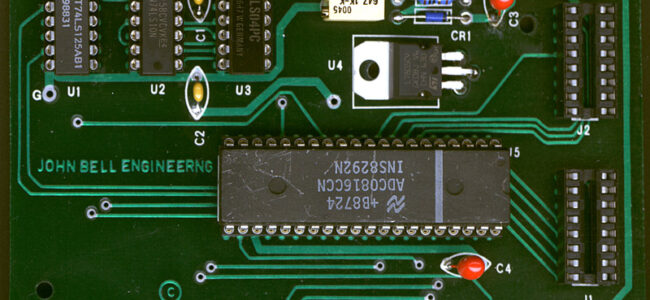
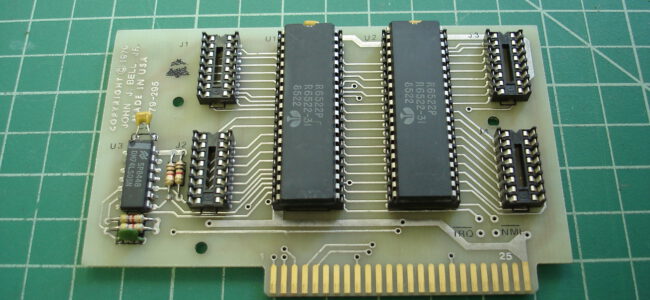
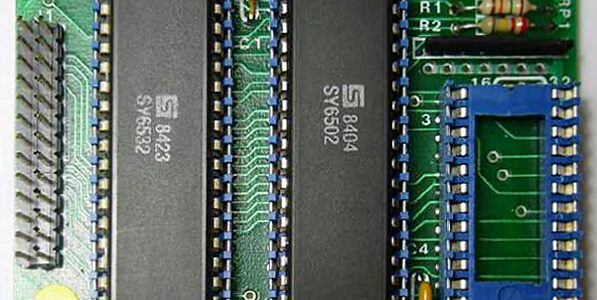
PN 82-300
6502 CPU, 6532 RIOT, 2716 or 2532 EPROM
One of the smallest 6502 based computers possible with the technology of the 1980ties!
Circuit Diagrams with thanks to Dallas Shell
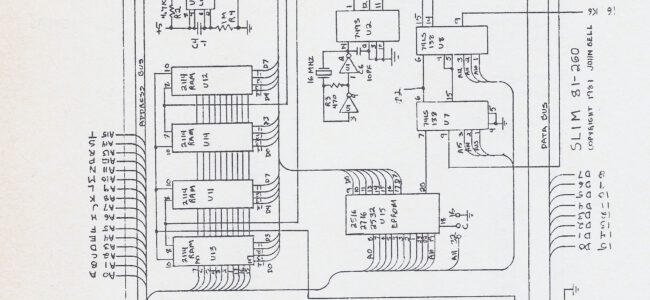
PN 81-260
A larger 6502 SBC, 2 VIA 6522, 2K RAM, RK ROM
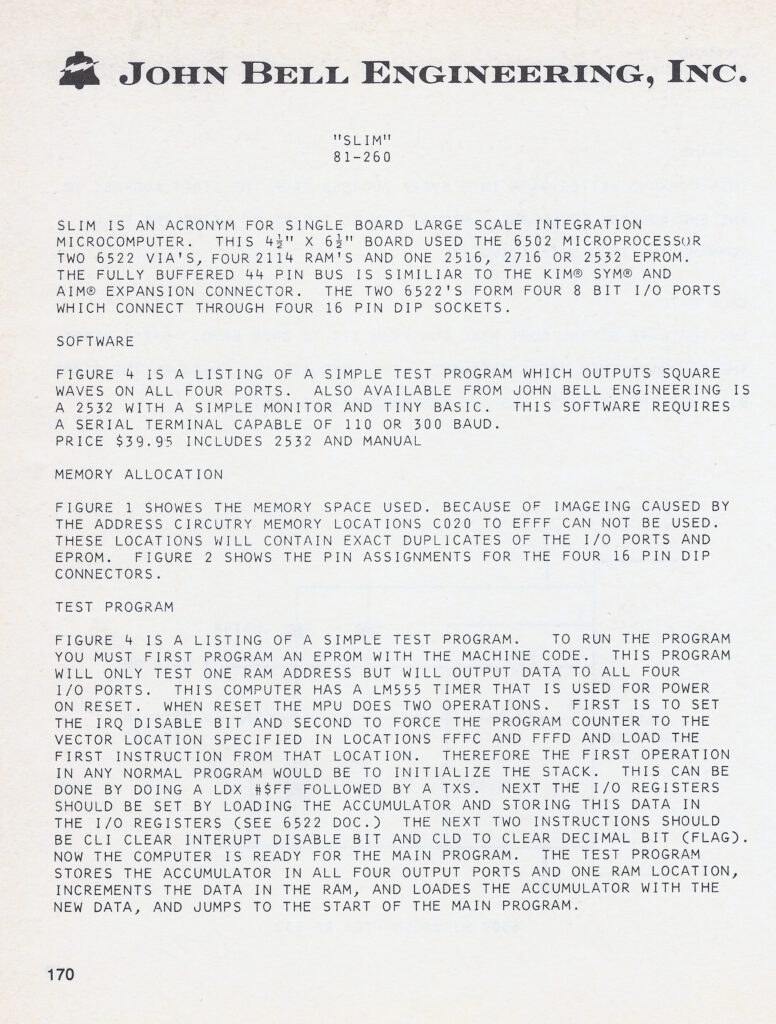
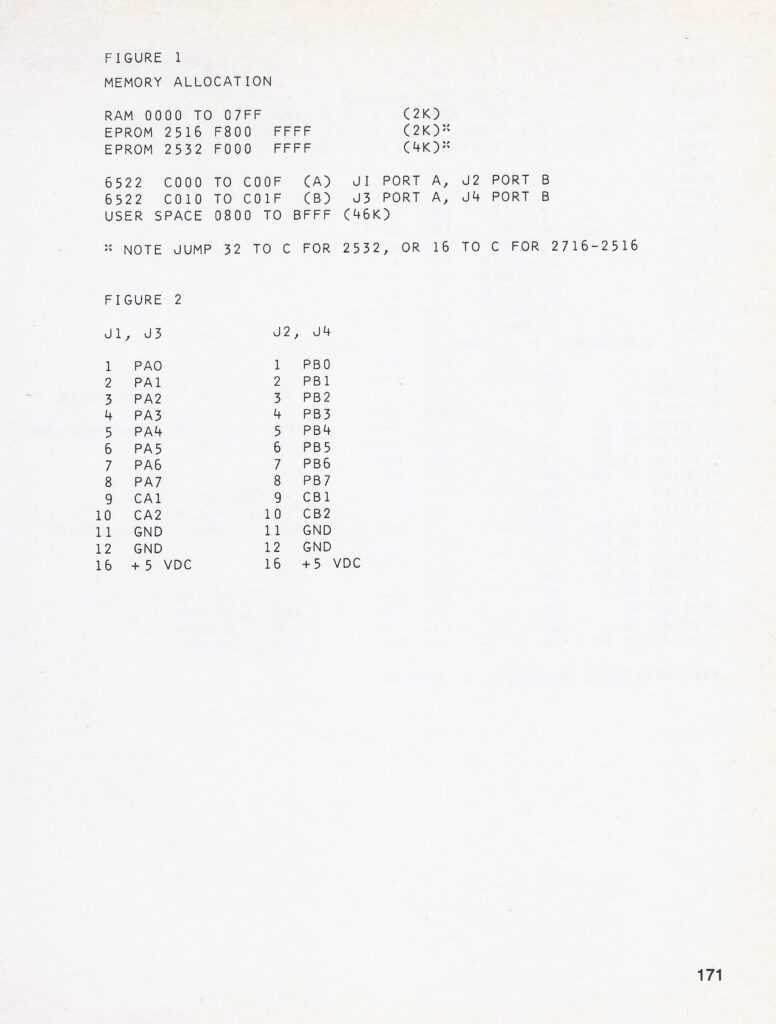
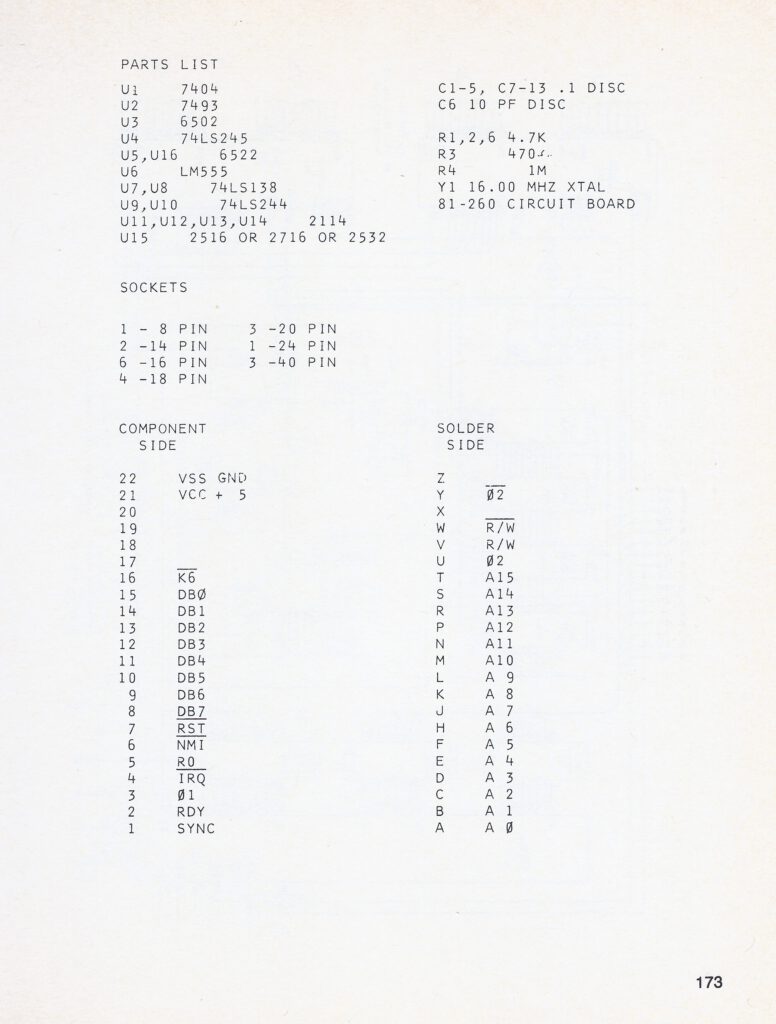

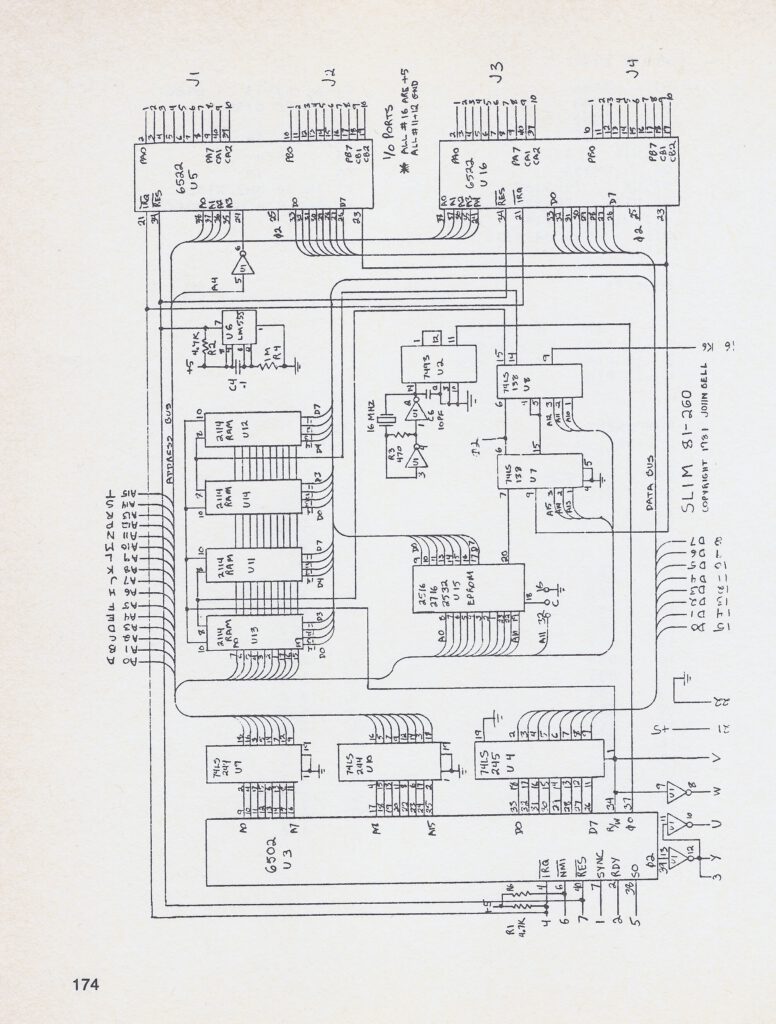
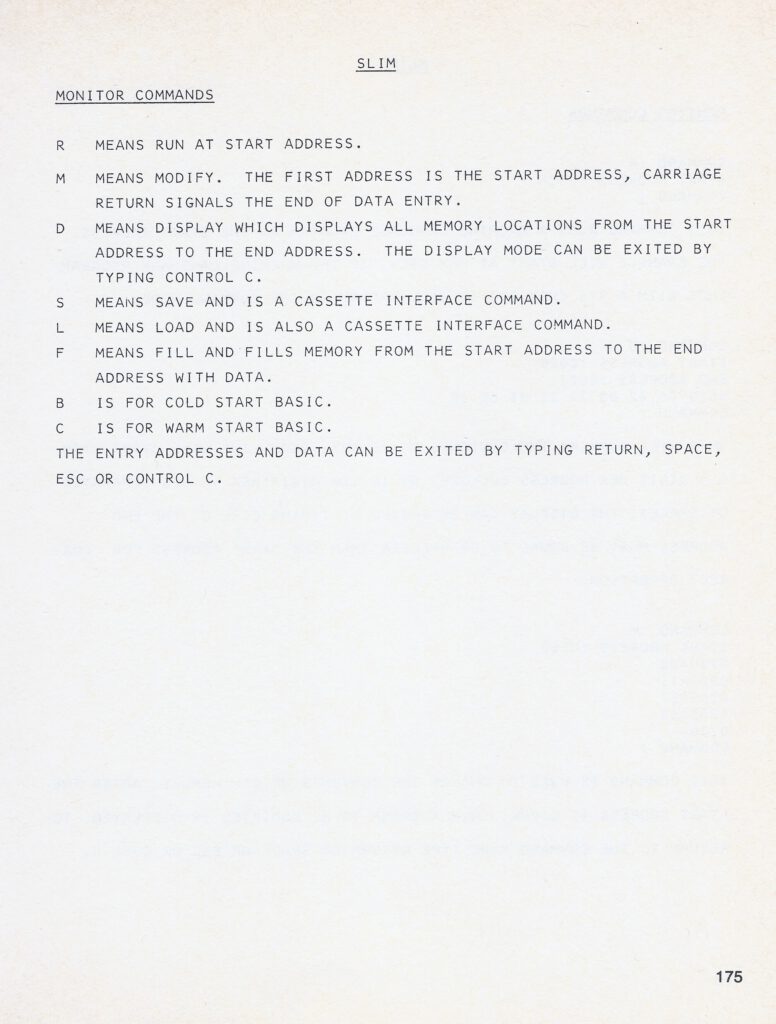
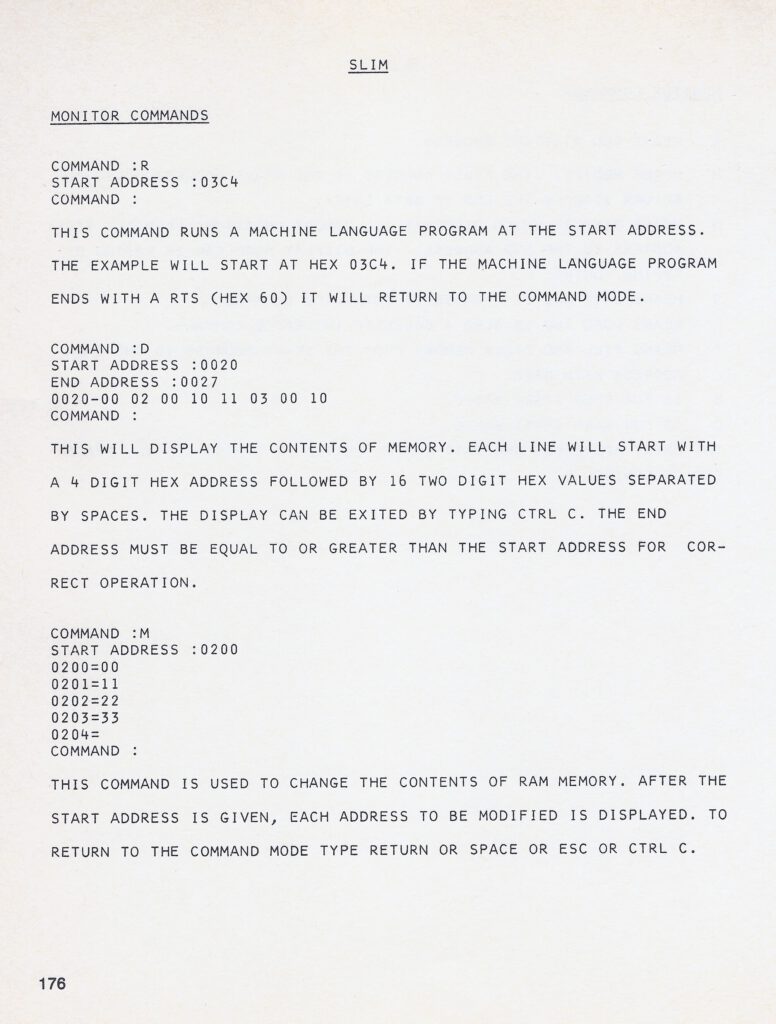
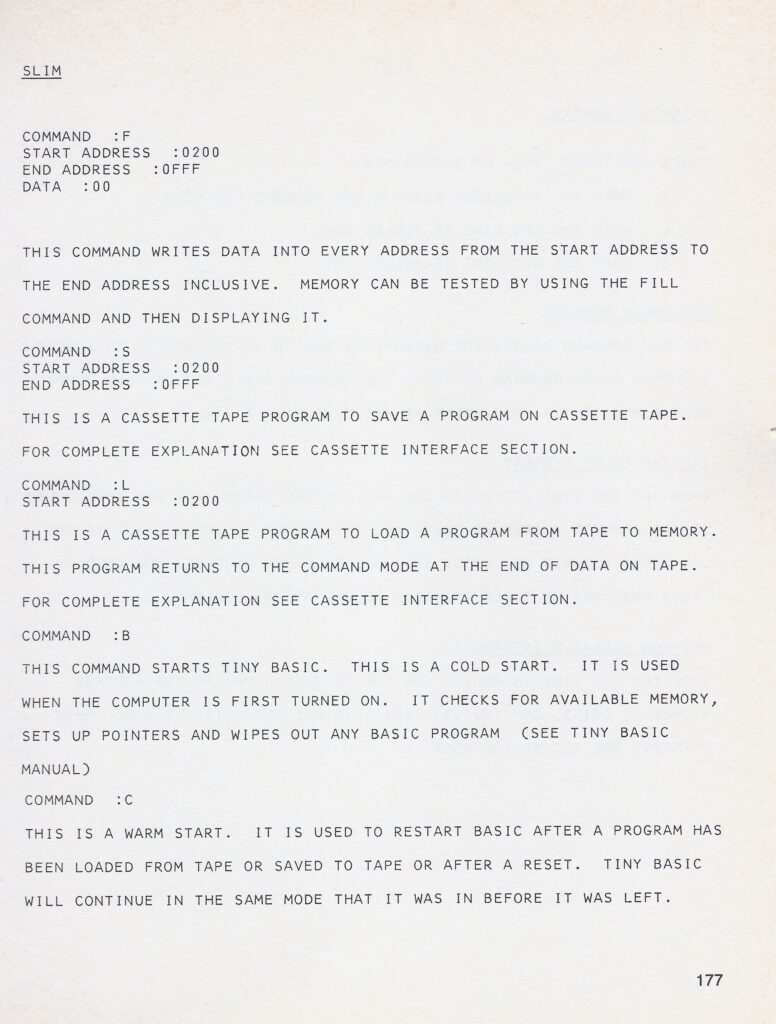
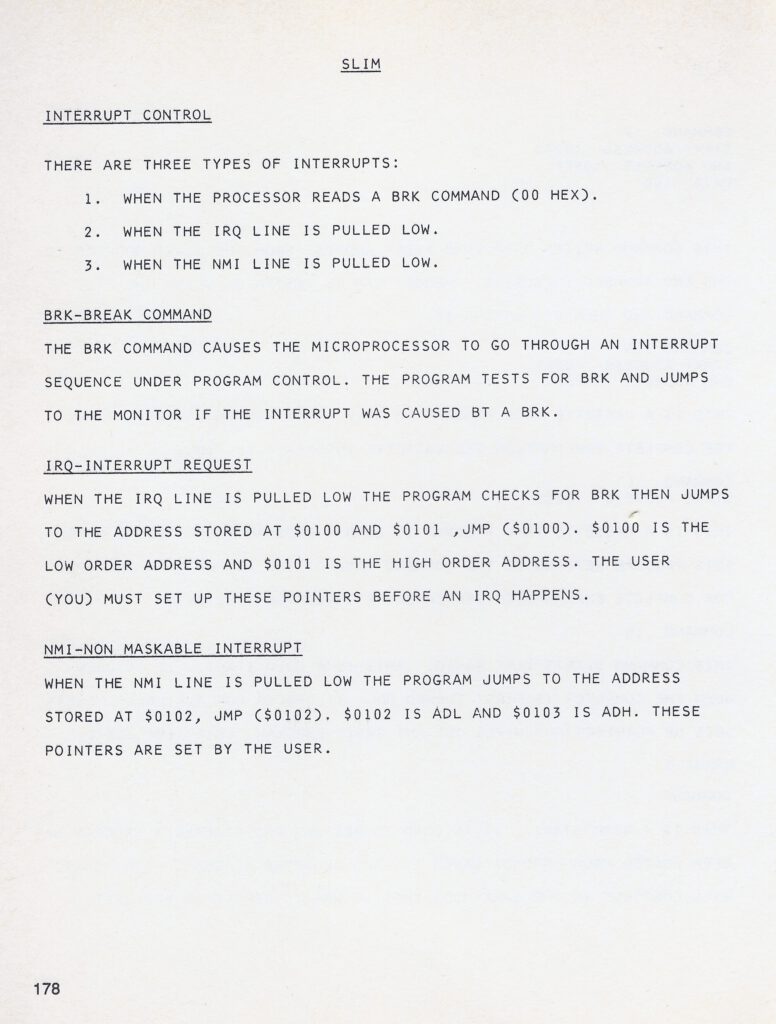
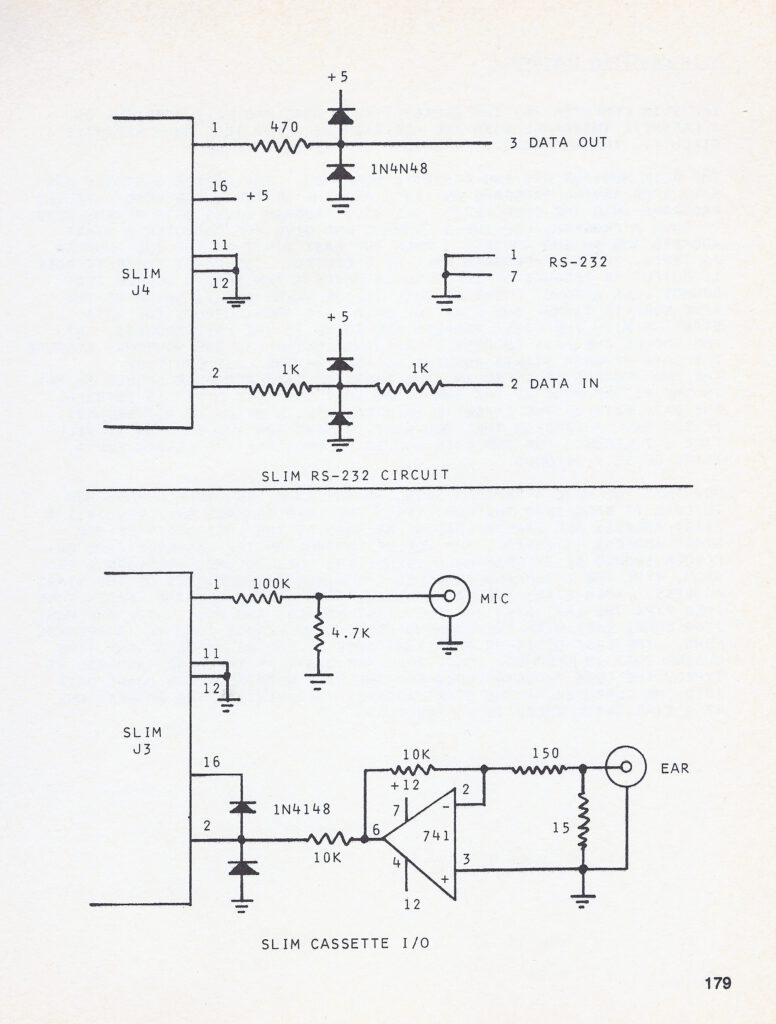
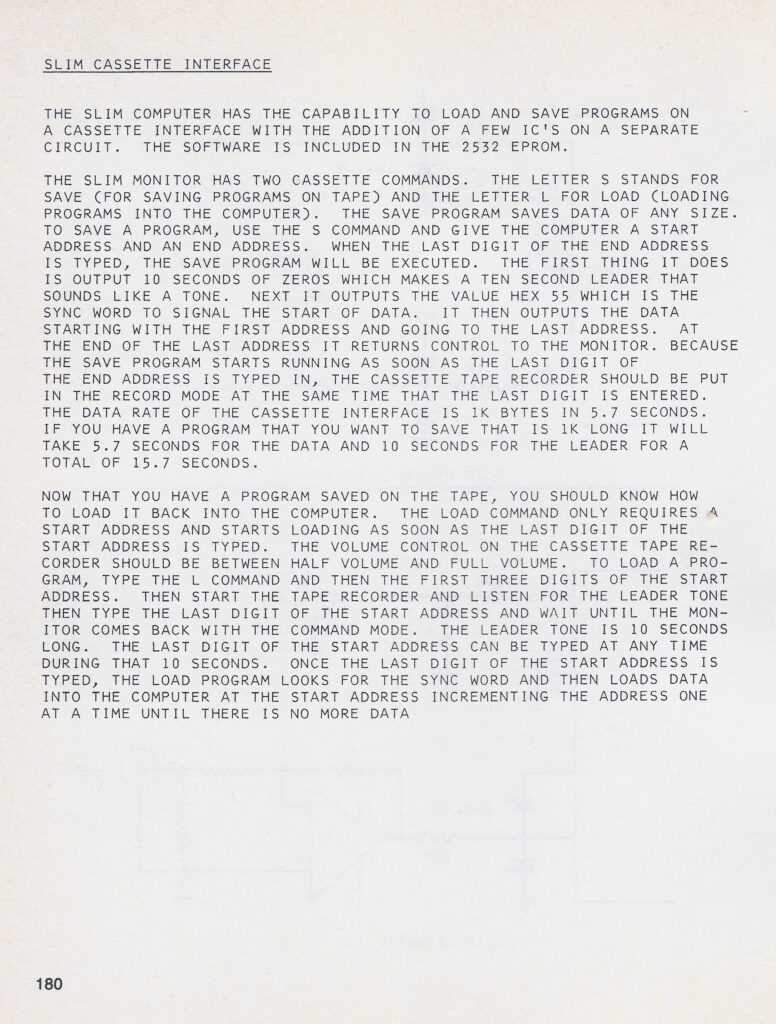
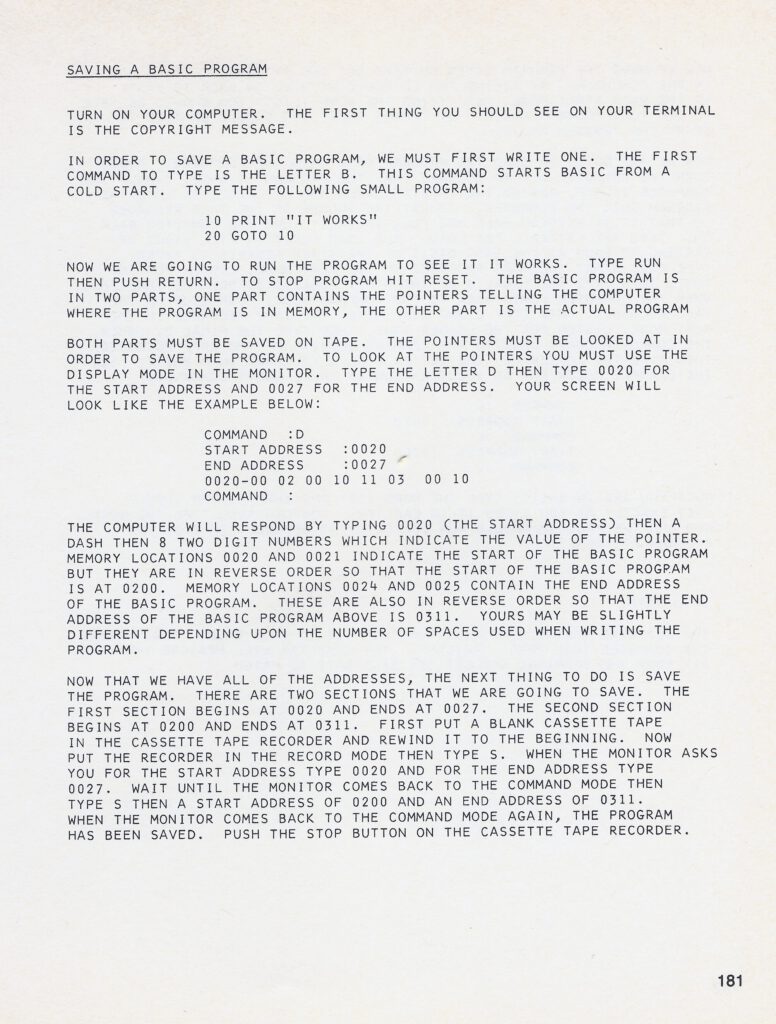
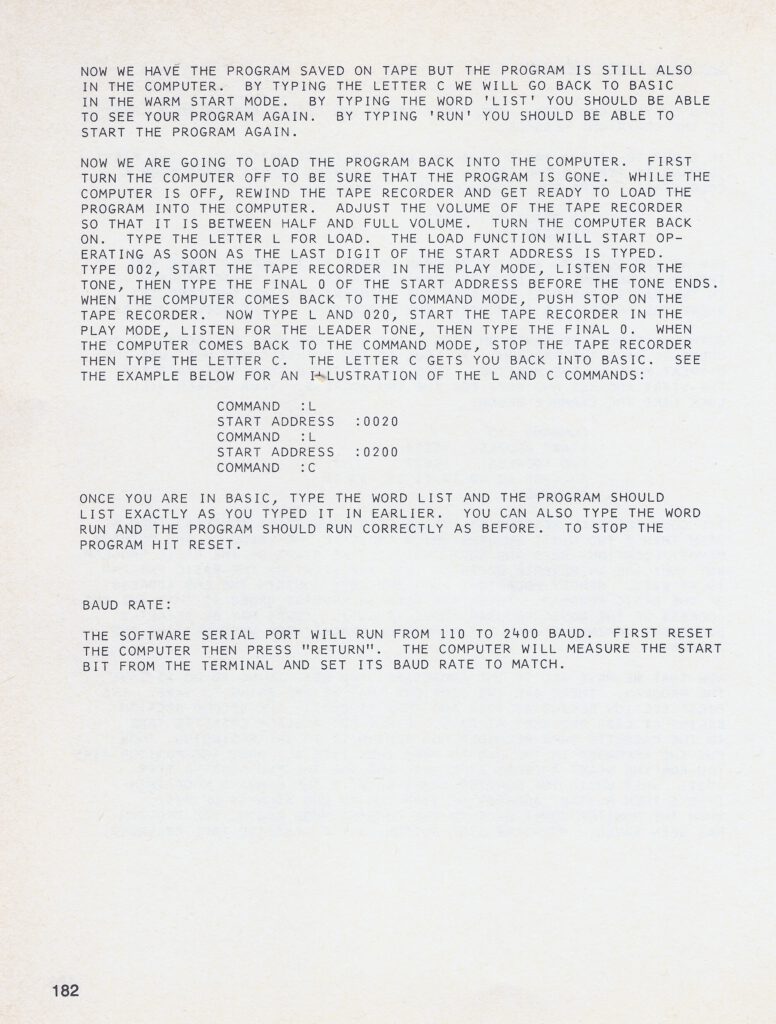
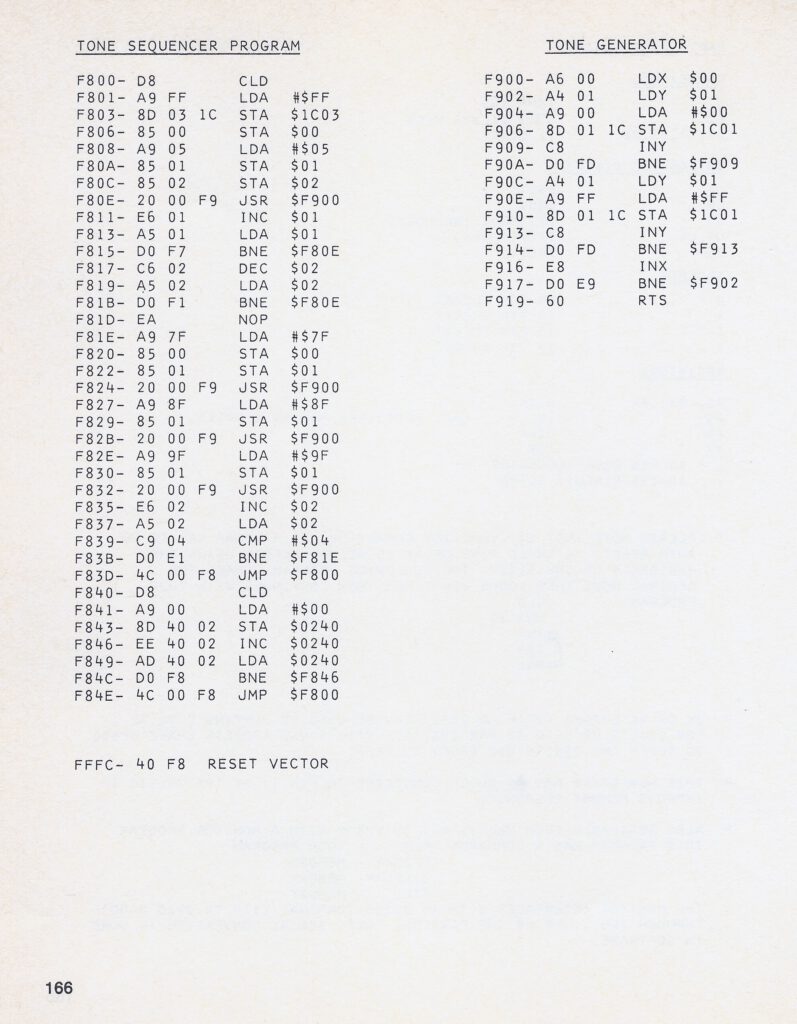
PN 80-153
Five IC’s on a SBC: 6502, 6522 VIA, 2716 EPROM, 2x 2114 SRAM, 74LS10 decoder
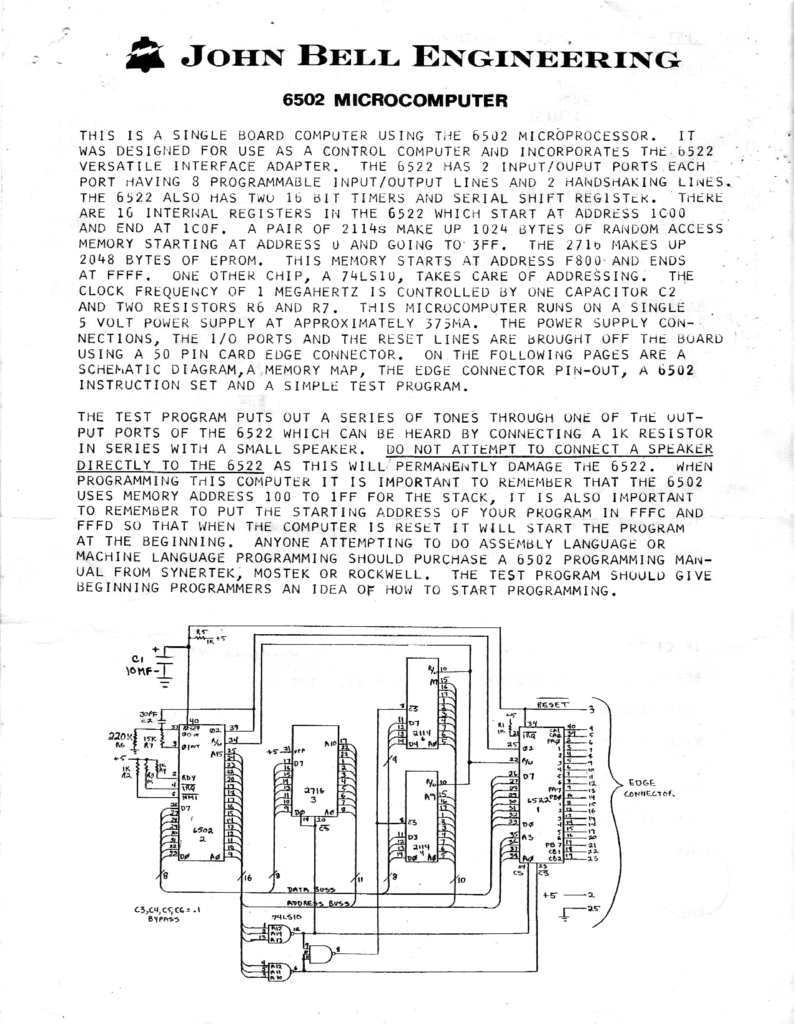
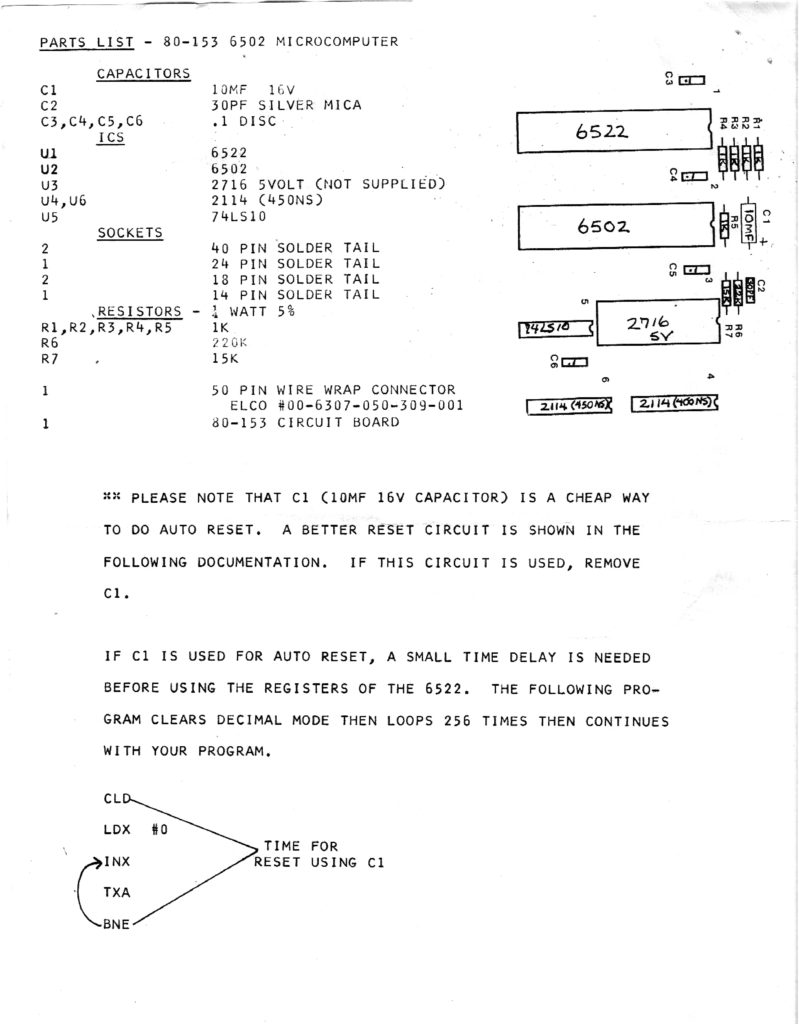
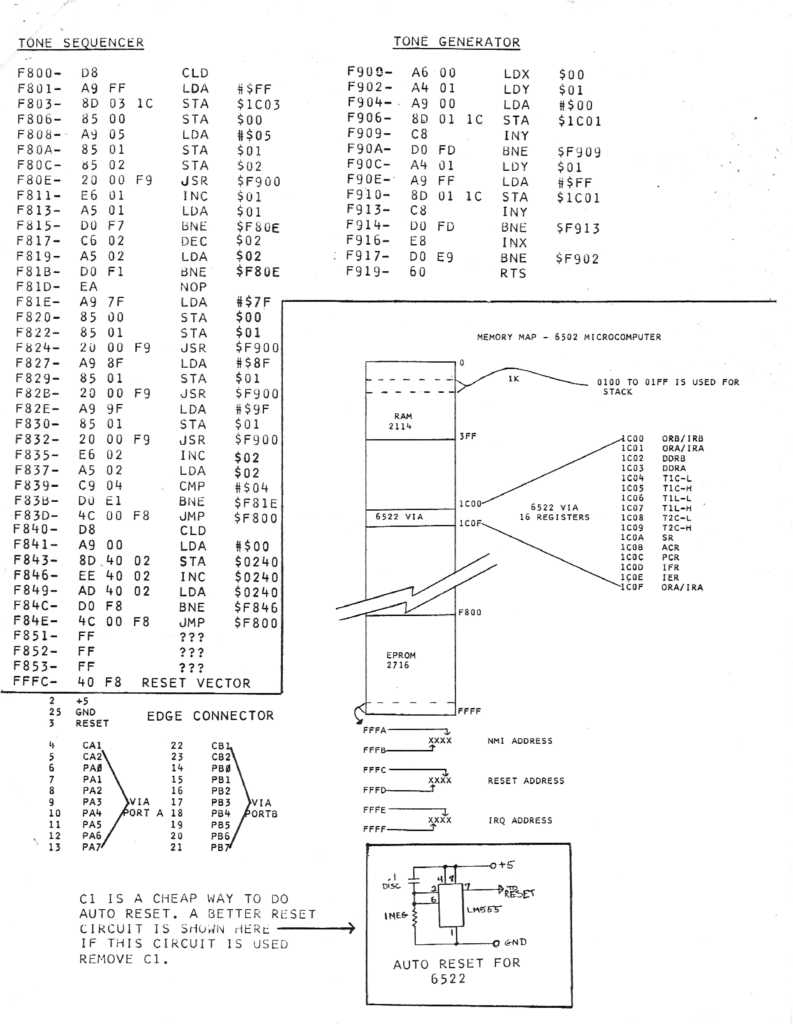
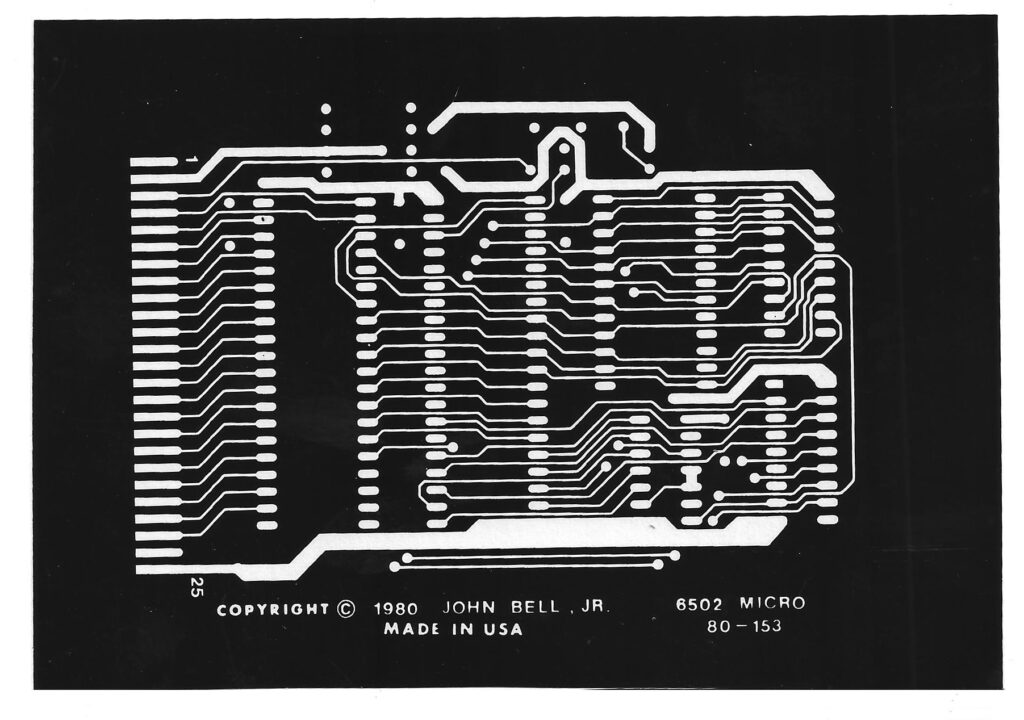
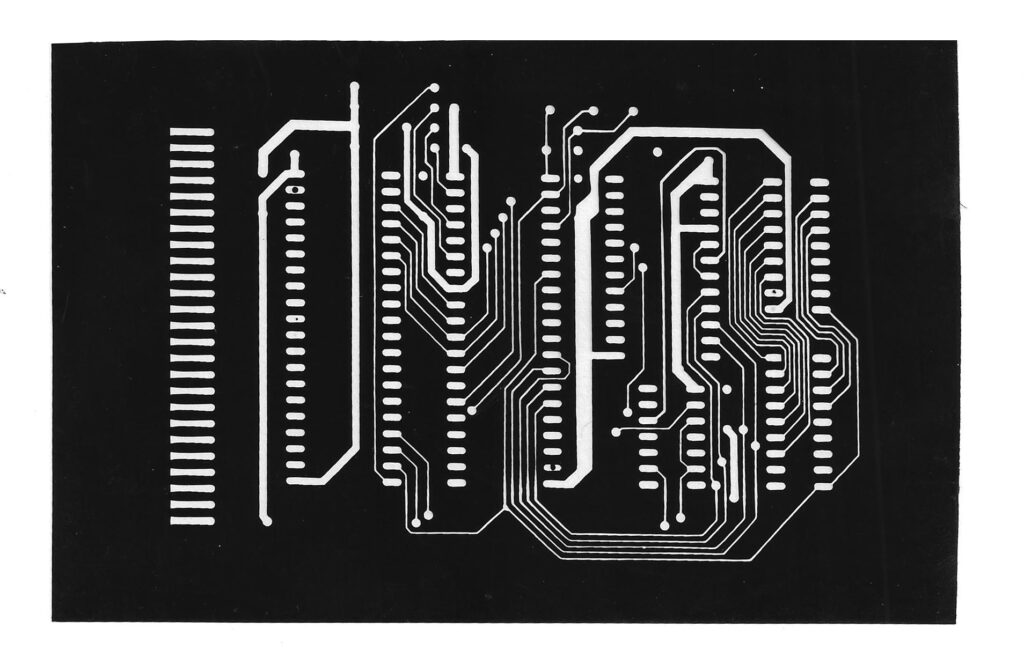 PCB images by Glen Deas, thanks!
PCB images by Glen Deas, thanks!
(Clock modification with crystal, Don Sawyer)
This is a revision, connecting phi2 to pin 11 of the ‘LS10, “to improve memory response”, so the wire is soldered!
Development for my old 8 bit retro SBC’s has become much easier with fast PCs and good tools. All cross development.
What took hours on my KIM-1: load editor form tape -edit source – save on tape (multiple tape files if big) – assemble form tape to tape – load binary from tape – run
can now be done very fast.
Powerful text editors, cross assembler, KIM-1 Simulator, seconds per iteration.
The only slow part remains: me!
More on my favorite toolchain here. 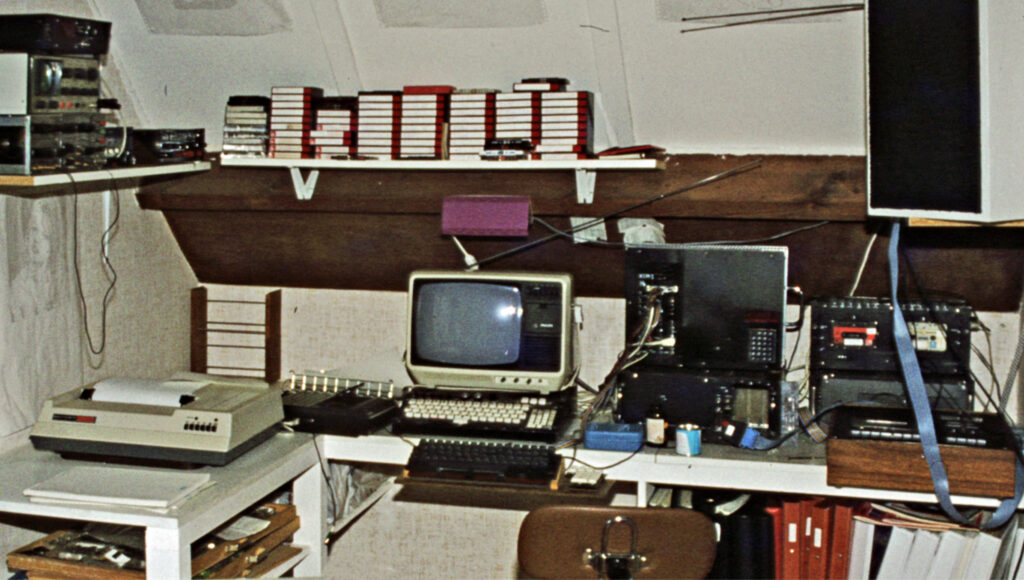
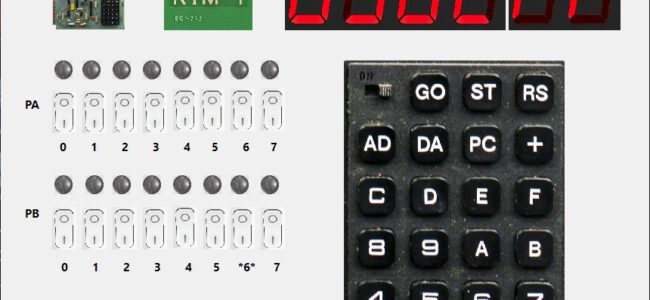
Updated December 2020, Linux compilation checked, bugs fixed, online program for comverting binary to wave file.
To aid in the handling of KIM-1 program and dataformats I have written some programs for Windows and Linux (Raspbian), sources included.
KIM-1 simulator
Convert 8 bit hex formats
KIMPaper
KIM Tape WAV to BIN conversion
KIMPoser Tape Convert hex to WAV online
KIM Tape Convert WAV to BIN and BIN to WAV
Pascal-M cross compiler
All programs come with source (Free Pascal Lazarus), compiled for Windows but thanks to Freepascal and Lazarus also compiled and tested on Linux (Ubuntu and Raspberry PI OS).
A general purpose utility to convert common 8 bit hex and binary formats, such as Intel HEX, Motorola S records, MOS Papertape, hex format, and binary files.
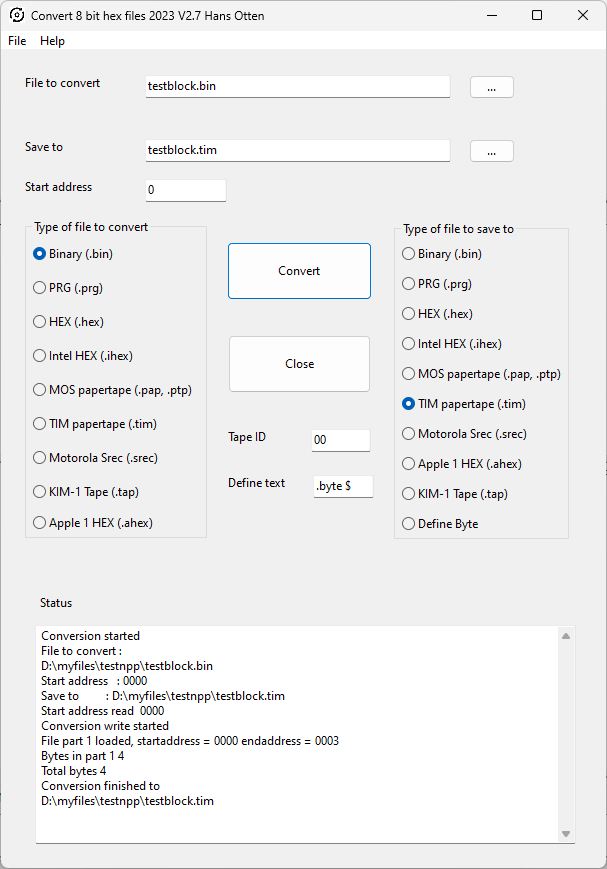
Sources (Freepascal Lazarus).
Convert8bithexformat Setup for Windows, Executables for Ubuntu and Raspberry PI OS
Available formats:
– BIN binary, raw data, no formatting, no information on start address.
– HEX formatted as hex numbers raw data, no start address included.
– IHEX Intel hex 8 bit format, multiple memory block, start address included.
– PAP MOS Technology papertape format, multiple memory blocks, start address included.
– SREC Motorola 8 bit S record, contiguous memory block, start address included.
– A1hex Apple Woz monitor hex format, start address included.
– KIM Tape as used in the KIM-1 Simulator as emulation of audio tape files.
6502/65C02 CPU emulation, disassembler, TTY, KIM-1 keypad and LEDs.
See the KIM-1 Simulator page for more information.
Note that the Conver8bitHexFormat program is also capable of converting to and from Papertape format from many more formats.
Originally written for the launch of the MicroKIM, an older version is on the support CD.
When you attach a serial device like the teletype or a modern PC with Hyperterminal you can use the TIM monitor of the KIM-1. One of the functions is loading from and saving to a papertape device on the teletype. Now since this is a way to load and save data as a textfile this is in fact quite useful.
The Micro-KIM triggered me to modernize my conversion utility for MOS Technology papertape format dating from 1983, VAX/VMS and Turbo Pascal. A Windows and a commandline/console version are available.
KIMPAPER for Windows
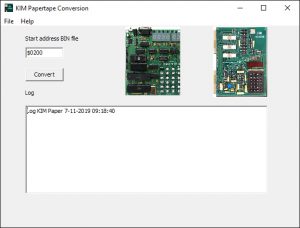
A program for Windows to convert between papertape and binary format.
Windows setup KIMPAPER
Sources (Freepascal Lazarus, build also on Linux)
KIMPAPER V1.1 for DOS
Not too modern, but handy, a commandline utility. Does exactly the same as the Windows program KIMPAPER. Runs fine in a commandline DOS box. Can also be compiled for Linux with Freepascal. In the KIMPAPER DOS archive the program, source and information on the program and papertape format can be found.
C:\MICROKIM\kimpaper KIM-1 MOS Technology BIN papertape format conversion utility, Hans Otten, 2007 v1.1 Syntax is: KIMPAPER [-[b|p] filename [startaddress] C:\MICROKIM\kimpaper -h KIM-1 Mos Technology BIN papertape format conversion utility, Hans Otten, 2007 v1.1 Syntax is: KIMPAPER [-[b|p|h] filename [startaddress] first parameter switches -h help -p convert to papertape -b convert to binary second parameter (first if no parameters, assumed binary to papertape) name of file to convert .BIN for binary, forces conversion to PAPertape .PAP for papertape, forces conversion to BINary third parameter (assumed 0000 if not present) startaddress for BIN to papertape conversion Files of type .BIN wil force conversion to papertape.PAP Files of type .PAP wil force conversion to binary .BIN Examples: C:\MICROKIM\kimpaper mastermind.bin 0200 KIM-1 Mos Technology BIN papertape format conversion utility, Hans Otten, 2007 v1.1 C:\MICROKIM>kimpaper mastermind.pap KIM-1 Mos Technology BIN papertape format conversion utility, Hans Otten, 2007 v1.1 Start address 0200 in file mastermind.BIN
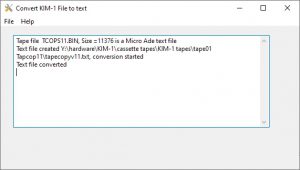
KIM Tape to Text is a utility to convert between binary format of a KIM-1 tape dump to a DOS text file.
The KIM tape dump is a binary file and is just a dump of part of the memory of the KIM-1.
This binary file can be a text file as used in editors Micro Ade or CW Assm/TED.
By using the tape write routine in the KIM-1 one can write an audio file on cassette.
When this audio file is captured on a PC as WAV file (22K, mono) this can be converted back to a binary memory dump with ED’s Utility KIMTape
These text files can be converted to DOS text files with this utility.
First open the binary file. If this is recognized as Micro Ade or CW Moser format, the Save as text file can be used.
Windows program.
Full source for Freepascal and Lazarus, no Windows dependencies. Compiled on 64 bits Windows 10 as 32 bit application.
Note on detection of assembler editor type
1. Micro Ade file must start with CR: when present this is Micro Ade
line nr follows 2 byte
line ends with $0D
file ends with $40
2. Assm/Ted by CW Moser starts with line number $10 $00
end of line is high bit set
There may be rare situations that a file starts with a $0D or a different line nr. You can force CW Mose detection by changing this to a sequence of $10 $00 $0D and if necessary blanks $20 to make it consistent. If in doubts: use an editor that shows the file in hex (Ultra Edit, or the free Notepad ++, Text editor PRO) and study the tape file.
Methods to get the binary file out of a Junior or KIM-1.
Read the record tape into a binary with Ed’s KIMTAPE conversion *see below). It is MS-DOS and runs fine in VDOS (https://www.vdos.info/) or DOsbox (slow).
Make a note of start address as shown by KIMTAPE.
Non-printing ASCII characters are filtered out of the resulting text file.
Not my program, but so handy!
KIMTAPE v0.5 – tape conversion utility for KIM-1 and SYM-1 (2004-05-17) Local copy of http://dxforth.mirrors.minimaltype.com/#kimtape)
KIMTAPE allows programs stored on cassette tape to be decoded to a program file. It handles both MOS Technology KIM-1 and Synertek SYM-1 tape formats including HYPERTAPE. The reverse process – converting a program file to an audio wavefile is also possible, allowing one to produce perfectly regenerated cassettes. KIMTAPE works with 8-bit mono WAV, VOC or RAW audio files recorded
at 22050 samples per second.
Download: kimtap05.zip (MS-DOS) It is MS-DOS and runs fine in VDOS (https://www.vdos.info/) or DOSbox (slow).
The binary files in the KIM-1 program archives have been reproduced, from the original cassette recordings, with the tool KIMTAPE on a PC in a DOS box. See Eds DX-Forth and Utilities Page for this and other nice programs.
This program also makes it possible to reproduce the original cassette recordings that can be read by a KIM-1.
The files were made as follows: The KIM-1 cassette audio was connected to the PC audio input and (with e.g. Audacity) recorded as a wave file (mono 22KHz).
For example: qchess.wav
The wave file was then converted with KIMTAPE to a binary file (the exact content of of the KIM-1 memory when recorded).
And the KIMTAPE utility then displays load address (for example and tape ID
c:\kimtape qchess.wav qchess.bin KIMTAPE version 0.5 17-May-04 infile: qchess.wav outfile: qchess.BIN Program 01 address 0200 checksum OK xxxx bytes done
This .bin file (any extension is fine!) is NOT a wave file! It contains the exact content of the KIM-1 memory when recorded. The size is exactly the number of bytes as stored in the memory of the KIM-1 and much smaller than the wave file. This binary file can be converted back to a wave file with KIMTAPE or converted to a papertape file with KIMPAPER:
C:\kimtape -M -A0200 -D01 -B2 qchess.bin qchess.wav
As you can see: you have to specify the load address and the program ID. The B parameter indicates hypertape speed (2 here, slow)
The resulting wav file should be acceptable for the KIM-1. It is (as I have tested) acceptable as input for KIMTAPE!
All command parameters can be seen by typing KIMTAPE without parameters:
Executables of cross compiler, workflow, sources, command line utilities.
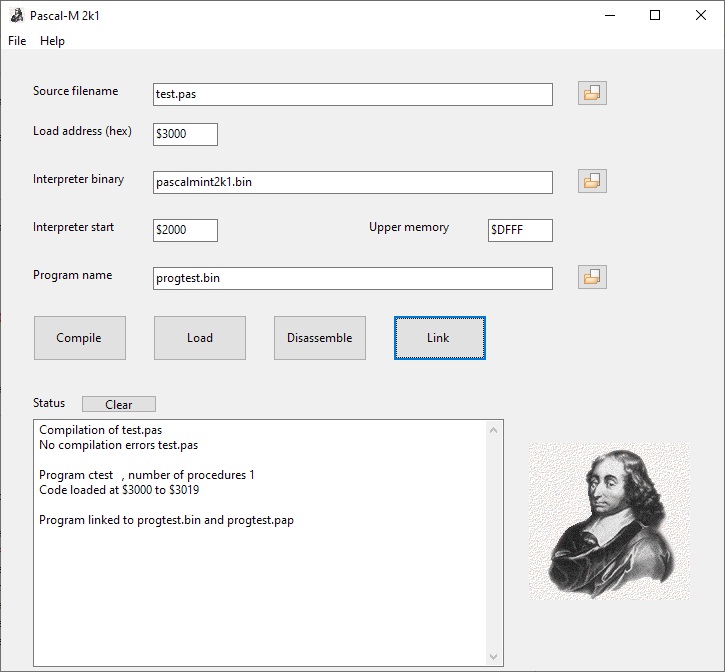
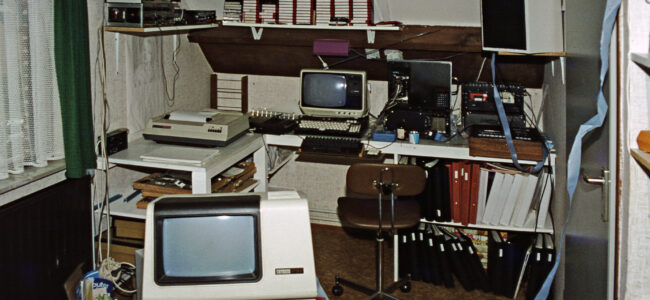
About my toolchains for retro computing.
Tools are very personal choice, what works for me. I use Windows (11 now) as my main workstation and often the command line. I do have Linux desktops for compatibility testing. As I grew up in the 80ties with mini’s like HP1000, PDP-11 + RSX-11M, VAX/VMS, MS-DOS, all command line, many many editors, from line editors to screen oriented (EDT from DEC was great!) with all kind of automation tools and code management, I feel comfortable with what Windows (and Linux) offer me now, it makes me very productive! YMMV, pick your tools as you like it.
Tools development
When there is not a tool available that does easy what I need, I write my own. GUI or command line, depending on the context.
My toolchain consists of Freepascal (commandline) and Lazarus (GUI).
Most tools have to do with manipulating binary data as to be expected. Other areas are compilers and simulators.
Resulting tools run on Windows, Linux and Apple Mac’s. See the
I have quite a collection of 8 bit computers, 6502, Z80, 6809.
Each processor comes with its own machine language, and for each processor myriads of assemblers have been made, each with its own deviations of the official syntax and way they operate. The simple ones are two-pass assemblers generating binaries and listings and symbol tables. More advanced are made up of an assembler and a linker. Linkers are nice and powerful, but a bit overkill for simple projects. I like command line assemblers, callable from an editor.
Notepad++ Editor
A very powerful text editor, with syntax highlighting, multiple files windows open, good search, plugins like hex editor and external tools support.
Add scripts to nppexec such as (requires TASM 2 installed, read below)
TASM32
This is a command line assembler that supports processors like 6502 and Z80. Output is binary, MOS papertape, Intel Hex, Motorola S-record. Listings and symbol tables (for the KIM-1 Simulator) can be generated. Used from Notepad++ as Tool, no need to start from the command line.
Test and debug
The output of the assembler can be downloaded to the SBC. Burn an EPROM, download hex or papertape. And test the code.
For KIM-1 programs I always use the KIM-1 Simulator debugger on the PC.
Set breakpoints and watches, trace the code, inspect memory, run the program.
When it is a TTY console program, I sue a terminal emulator, Teraterm.
2400 baud 8 bit, one stop bit, no parity, 5 ms character delay, 20 ms line delay for papertape upload.. Higher baudrates may work.
For CP/M there are many emulators available, choose one that allows file from the PC to be accessed also by the emulator. E.g. the Z80 IDE and CP.M emulator of Hein Pragt.
CC65
I only use the assembler and linker of the CC65 package. Mainly for KIM-1 KB9 Basic development, as the source from Pagetable is in this format.
This is how I do it (Windows, can be done also on Linux)
ca65 -D kb9 msbasic.s -o tmp/kb9v2.o -l tmp/kb9v2.lst ld65 -C kb9.cfg tmp/kb9v2.o -o tmp/kb9v2.bin -Ln tmp/kb9v2.lbl
Winmerge
A tool to compare files, text and binary. Open the program, drop binary files from the explorer on it and see the differences highlighted. Essential to compare ROM dumps or to check if assembler source assembly leads to identical binary as the original. Detects subtle syntax differences from sources converted or disassembled, leading to different code.
Disassembler
Still searching for a good multiprocessor tool. With some intelligence, like input files not only binary, but also a symbol file and tips of what is data and what is code. Output should be in assembler format ready to assemble. A multipass operation, where you learn from each iteration symbols and data areas.
For 6502 code I use the online tool at Virtual Disassembler. Drop the binary and copy the code. Choose the output format, like “listing” or “assembler”. You can input a symbol file.